#Festival Dada 1920
Explore tagged Tumblr posts
Text

André Breton portant la cible dessinée par Francis Picabia au festival Dada de 1920.
1 note
·
View note
Text
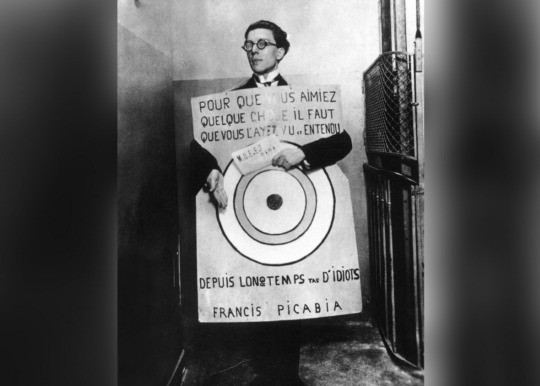
Uncredited Photographer André Breton at Festival Dada, Paris 1920.
"L'œil existe à l'état sauvage." (Eyes exist in the savage state). André Breton, "Le Surréalisme et la Peinture" 1926
37 notes
·
View notes
Text
Weren’t cool those days?
#midnightinparisfeelings
1. Adrienne "Ady" Fidelin & Man Ray in Mougins, by Lee Miller, 1937
2. Leonor Fini, Paris, 1936 by Dora Maar
3. André Breton at a Dada festival in Paris, wearing a slogan by Francis Picabia: ‘In order to love something you need to have seen and heard it for a long time bunch of idiots’,1920



2 notes
·
View notes
Text
Arts-Music .. an A to Z
A Brainstorm Chat Dedicated Essentially For Giving Humble Insights and Joy to Kill the Loneliness you May Notice On this Period and Quench your Reading and Singing's Thirst Using Virtues of soothingWords like a Xylophone than can make You sleep Zzzzz…
A capella:
A cappella is a phrase used in vocal music indicating that a song or part of a song, in one or more voices. It is also the name of a chant performed without instrumental accompaniment. It is a pure, authentic and a rudimentary yet very soothing type of chant.
Blues:
The blues is a musical, vocal and instrumental genre derived from the working songs of the African-American populations undergoing racial segregation in the United States. The blues first appeared in the southern United States during the 19th century. It is a style where the singer expresses his sadness and his disappointments.
Country music:
Country music is a mixture of traditional music developed mainly in the southeast of the United States and in the maritime provinces of Canada, but also in Europe as in Ireland or in the north of the Netherlands. Country music evolved rapidly in the 1920s and remains very popular today. Different gender variations have also emerged in other countries such as Australia.
Dada:
The Dada movement is an intellectual, literary and artistic movement from the beginning of the 20th century, which is characterized by a questioning of all ideological, aesthetic and political conventions and constraints.
Existentialism:
Existentialism is a philosophical and literary current which considers that the human being forms the essence of his life by his own actions, these not being predetermined by theological, philosophical or moral doctrines.
Funk:
Funk is characterized by the predominance of the rhythm section (guitar, bass, drums) which plays syncopated patterns, the frequent presence of brass or saxophones on rhythmic punctuations (riffs) or solos and, in general, by the great place given to instruments. It has emerged from a mix of soul and jazz music.
Gnawa:
Gnawa music is a body of Moroccan and other North African Islamic religious songs and rhythms. Its well-preserved heritage combines ritual poetry with traditional music and dancing. The music is performed at "lila", communal nights of celebration dedicated to prayer and healing guided by the Gnawa maalem, or master musician, and their group of musicians and dancers.
Humanism:
Humanism is an idealist and optimistic current of thought which places Man at the center of the world, and honors human values. It has shaped many facets of the contemporary world.
Impressionism:
This pictorial movement is mainly characterized by small paintings, visible brush strokes, open composition, the use of unusual viewing angles, a tendency to note fleeting impressions, the mobility of climatic and light phenomena, rather that the stable and conceptual aspect of things, and to transfer them directly to the canvas. Claude Monet and Paul Cézanne are notorious members and founders of the impressionist movement
Jazz:
Jazz is a music genre that originated in the African-American communities of New Orleans, United States. It originated in the late 19th and early 20th centuries, and developed from roots in blues and ragtime. Jazz is seen by many as "America's classical music".
Karaoke
Karaoke (カ ラ オ ケ, karaoke) Is an entertaining way to sing, usually by following the lyrics on a screen.
Liberalism
Liberalism is based on freedom and recognition of the individual, its initial purpose is to rationalize and order social relations.
Metal
Heavy metal (or Metal) is characterized by the dominance of the guitar and the drums, as well as a powerful rhythm. It draws its influences from rock, classical music and the blues.
Naturalism
Naturalism is a literary movement which, in the last decades of the 19th century, sought to introduce into the novels the method of the human and social sciences, applied to medicine by Claude Bernard. Émile Zola is the main representative of this literary school in France. The movement will spread throughout Europe to America.
Opera
An opera is a musical and theatrical work for an orchestra and singers, built on a libretto which depicts characters and their history, where the roles are sung. Opera is one of the lyrical forms of Western musical theater.
Pop
Pop music (or simply pop) is a musical genre that appeared in the 1960s in the United Kingdom and the United States. These songs usually talk about love or relationships between women and men.
Qajar Art
Kadjar art (or qadjar) is an art form that developed in Kadjar Iran, which lasted from 1794 to 1925. The period during which the Kadjar dynasty reigned experienced a strong development of the arts, made possible by a period of relative stability in the country's history, allowing artistic development especially under the reigns of Fath Ali Chah Qadjar.
Rock
It has its roots in rock 'n' roll of the 1940s and 1950s, itself greatly influenced by rhythm and blues and country. Rock has also incorporated elements from other genres including folk, blues, jazz and classical music.
Symbolism
For the symbolists, the world cannot be limited to a concrete appearance that can be reduced to rational knowledge. There is a mystery to be deciphered in the correspondences which strike inanity the partitioning of the senses: sounds, colors, visions participate in the same intuition which makes the Poet a kind of mage
Techno
Techno is a genre of electronic music that emerged in the United States in the mid-1980s. Most often composed in home studio and reinterpreted by disc jockeys during festive practices, techno is above all dance music, in essence repetitive
Ukiyo-e Ukiyo-e (浮世 絵?, Japanese term meaning “image of the floating world”) is a Japanese artistic movement from the Edo period (1603-1868) comprising not only an original popular and narrative painting, but also and above all Japanese woodcut prints.
Vocal Jazz
Vocal jazz is a sub-genre of jazz, where the voice predominates within the composition. It is thus frequently opposed to instrumental jazz, where the playing of musicians predominates.
Waila
Chicken scratch (also known as waila music) is a kind of dance music developed by the Tohono O'odham people. The genre evolved out of acoustic fiddle bands in southern Arizona, in the Sonoran desert. These bands began playing European and Mexican tunes, in styles that include the polka, schottisch and mazurka
Xote
Xote – is a Brazilian music genre and dance for pairs or groups of four.
YéYé
Yé-yé was a style of pop music that emerged from Southern Europe in the early 1960s. The term "yé-yé" was derived from the English term "yeah! yeah!"
Zadjal
Zadjal adapts well to music. It reached its peak with Ibn Quzman, Andalusian poet adapted from Cordoba, who used it for his panegyrics, but also to sing nature, wine and especially love.
Aymane Moataz, El Mehdi El Bachiri.
2 notes
·
View notes
Photo

[Affiche Dada] Tract Dada - Festival Dada À La Salle Gaveau EDITION ORIGINALE This is the first edition, original program leaflet announcing the festival of the Dadaist group of Paris at the Salle Gaveau on Wednesday, May 26, 1920. The model of this poster was designed by Tzara and Picabia. Mechanical illustration overlaid by Picabia. Listed on Biblio by Librairie Le Feu Follet in Paris, France. https://www.biblio.com/book/affiche-dada-tract-dada-festival-dada/d/1251321984 #dadaist #arthistory #festivaldada #1920s #picabia #tzara #paris #sallegaveau
1 note
·
View note
Text
Constantin Brâncuşi Festivalul Dada (26 mai 1920)
Constantin Brâncuşi Festivalul Dada (26 mai 1920)
Astăzi, 26 mai 2020 se împlinesc 100 de ani de când Constantin Brâncuşi a participat, la Paris, la Festivalul Dada, alături de André Gide, Paul Valéry, Fernand Léger şi alţii, fiind unul dintre semnatarii manifestului intitulat Contre Cubisme, contre Dadaisme.
„În plin avânt al mișcărilor avangardiste, artistul român își arată o față pe care puțini o cunoscuseră și care a produs, în rândul…
View On WordPress
#Adina Romanescu#artă plastică#Constantin Brâncuși#cultură#dada#Daniel Onaca#Festival Dada 1920#Greta Knutson#istorie#literatură#muzică clasică#Paris#poezie#revista trimestrială leviathan#societas#teatru#Tristan Tzara
0 notes
Link

André Breton portant un costume dessiné par Francis Picabia au festival Dada à Paris, 1920
9 notes
·
View notes
Text
Stop, Stop, Stop, Pause
Today’s Object of the Day celebrates the winners of Cooper Hewitt’s National Design Awards. Honoring lasting achievement in American design, the Awards take place annually during National Design Week, with festivities for all ages celebrating design creativity and innovation.
Pause is a strong graphic pattern using typographic characters that notify the reader to stop and pause, so is a literal, and amusing, descriptive title. The design, using typographic characters not frequently featured as decorative motifs, is a repeating pattern of three periods followed by a comma, with the second row offset one space. Pause is from 2×4’s Chatter collection of wallcoverings produced by KnollTextiles. Typography has been used as a motif in wallpaper design since the 1920s, when French artist Jean Lurçat inserted nonsensical messages into some of his Dada wallpaper designs. In the 1950s, Alexander Girard created a pattern of closely spaced capital letters and numerals having the appearance of random strikes on a typewriter. Printed in a single bold color on a contrasting ground, like Pause, the designs are quite striking. The use of typography as a decorative element reached its peak in the 1960s, with designs resembling graffiti, and mod murals composed of large-scale overlapping letters. Earlier examples tend to involve more words and phrases, while designs from the 1960s begin featuring typographic characters as motifs. Typography was first used on children’s papers in the 1870s, but served an educational rather than decorative purpose. While the use of typography as a decorative element has been around for a while, this design shows it being used in a unique way and helps demonstrate the evolution of type as a motif.
2×4, a design firm based in New York whose focus is brand strategy for clients who value the power of design, was the winner of the National Design Award in Communication Design in 2006.
Gregory Herringshaw is the Assistant Curator in the Wallcoverings Department.
from Cooper Hewitt, Smithsonian Design Museum https://ift.tt/2CLuJNb via IFTTT
2 notes
·
View notes
Text
OKTOBERFEST
Hoy hablaremos del Oktoberfest es una gran celebración en Alemania común mente se celebra entre los meses de septiembre y octubre desde 1810 en la ciudad de Bavara de Munich, sin duda alguna es la fiesta mas popular y mas grande de Alemania y no solo de Alemania si no que esta gran celebración es enormemente reconocida a nivel mundial y de las más grandes del mundo, con visitas anuales superiores a los seis millones de visitantes.
La próxima fecha de celebración será desde el sábado 17 de septiembre hasta el 03 de octubre de 2022 varias semanas de celebración para los amantes de la cerveza.
Ahora les contare algunos datos curiosos de esta gran celebración.
· Comienza el primer sábado después del 15 de septiembre.
· Y se celebra en un espacio verde situado junto a la muralla conocido como Theresienwiese o “prado de Teresa”
· El primer Oktoberfest tuvo lugar en el año 1810, entre el 12 y el 17 de octubre, como celebración de la boda entre el príncipe Luis I de Baviera y la princesa Teresa de Sajonia-Hildburghausen. Sin embargo, esta primera celebración tuvo como evento principal una carrera de caballos, algo mucho más adecuado para una boda de ese calibre.
· En la actualidad el Oktoberfest termina el primer domingo de octubre.
· La historia de este festival también tiene capítulos un poco más tristes, pues durante la Primera Guerra Mundial, no pudo celebrarse. En 1919 y 1920 pasa a llamarse «festival de otoño» (Herbstfest). En los siguientes años de la década de los años 20, a causa de la inflación que surfía Alemania, volvieron a verse obligados a cancelar la celebración del Oktoberfest.
· Ya en la segunda mitad del siglo XX los bávaros consiguieron volver a reunirse y brindar con cerveza en este festival de otoño. No obstante, dadas las restricciones al alcohol que se dieron en muchos países, la cerveza usada en el Oktoberfest no alcanzaba lo un contenido alcohólico del 2%. Podría decirse que durante la posguerra brindaron con “cerveza sin”.
Hoy en día esta fiesta de la cerveza y del otoño congrega a millones de personas en Múnich y en Theresienwiese. Aunque este año no haya sido posible celebrarlo, el año que viene volverán a levantar sus jarras rebosantes de cerveza.
0 notes
Text
INTRODUCTION I have chosen to focus on jazz culture for my Final Major Project. Jazz originated in the 1920s, when it became popular all across Europe and America. The ‘roaring twenties’ and all that came with it allowed jazz to become hugely successful mainstream, in which musicians such as Louis Armstrong flourished. My father has always been a fan of jazz music, and grew up with it often in the background. Despite being fond of jazz too, my favourite music genre is 80s and 90s hip hop, featuring artists such as biggie smalls and Erika Badu, whist their music is classed as hip hop, they are both heavily influenced by jazz, and the free-flowing nature of it. I have noticed that within my favourite hip hop songs, jazz is at the core and this discovery is one of the reasons why I want to learn more about it. My favourite song ‘Because I’m me’ by the avalanches, uses instruments and has free flowing lyrics and layering that connects to jazz. The effect that it has on my mood is quite powerful. I am interested in learning more about jazz culture; jazz clubs, festivals, groups etc… and how they impact people, such as putting smiles on people’s faces, inspiring and influencing other genres of music, even changing political opinions. ‘The free-spirited nature of jazz spread throughout American culture. Women began to break out of traditional sexual roles, shunning conservative clothing and behavior for a newfound freedom and independence from men and obligatory roles within families. Jazz made room for women to work as performers and provided many other jobs for women in the music industry.’ Taken from the article - how jazz works by Cameron Lawrence.
My initial research of jazz started from me going through my own personal Spotify playlist, which I made during the first lockdown, during this time I fell back in love with it, and it helped me keep positive. Songs such as ‘move on up’ by Curtis Mayfield, ‘door of the cosmos’ by Sun Ra and ‘moon light’ by Apple and The Three Oranges are just a few of my favorites. From my initial blog research, the movement of jazz musicians, whether it is dancing onstage or playing instruments is an area that I believe to be a potential starting point. From looking at photography of jazz musicians, in particular male musicians, they are often in suits, which are fairly restrictive in terms of arm movement in actions such as playing the trumpet. Looking into the way jazz music can have an effect on people’s moods and emotions is another potential starting point. According to psychology experts, jazz can reduce stress levels and it can help you study or learn a new skill. Following on from this, the power of music within political change is also something I want to research more into and learn more about.
Jazz to me seems like the closest way of expressing art in audio form. The instrumentals feel like brush strokes and the lyrics like mark making, together creating a layered masterpiece filled with expression and depth. And I think that I am so drawn to it by curiosity, due to my lack of in-depth knowledge on this genre. I want to know how it is created, all the different types, the technical language, the choice of instruments and all their different sounds, the masters, jazz groups, festivals, club, and possible influence on popular culture and art and design in general.
CONTEXTUAL REFRENCES
During the decade of jazz origination, some of the most significant art movements of the 1920s were Dada, Surrealism, Expressionism and Art Deco, ‘Such events in art in the 1920s helped to re-define and re-shape all the major creative disciplines’ - Widewealls 1920s art history written by Silka P. The art of this period reflects the emotions of post war, filled with crazy imagination never seen before. Artists such as Salvador Dali and Marcel Duchamp were both pioneers, and playful with their work, much alike jazz musicians. Architecture at the time was also highly influenced by the art deco style, featuring rich colors, bold geometric shapes and lavish decoration. Many art deco skyscrapers emerged, such as the Chrysler building in east side Manhattan designed by William Van Allen.
The Writer F. Scott Fitzgerald, author of the great Gatsby, called the 1920s ‘the Jazz era’. The book, and also film depicts the huge lavish party scene of the 1920s, filled with jazz, dancing, and excitement. Popular cars at the time were the 1929 Ford Model A Deluxe Roadster, the 1920 Rolls Royce Phantom Limousine and the 1928 Falcon Knight Roadster. All these cars have an elegant design and make a large feature of their curves, from the bonnet to the wheels. During the 1920s, poets such as T.S. Elliot, Carl Sandburg, and E.E. Cummings were writing with less formality and less regard for conventional style, much alike jazz musicians, and the two forms came together to create jazz poetry.
It’s interesting that the next jazz movement was also post war, in the 1950s and 60s. Rebel abstract expressionism Artists such as Jackson Pollock and Mark Rothko rejected past styles such as Art Deco and Surrealism and focused on the act of experience of just painting. This movement influenced most art practices worldwide, such as Modern sculpture and Lyrical Abstraction. In 1945 jazz history was made when Charlie Parker and his own group were performing with Dizzy Gillespie on the side and together, they invented bebop, which is a style of jazz featuring a fast tempo, complex chord changes, instrumentals and improvisation. In the 1950s the popularity of television grew; it overtook radio and became the most important entertainment medium. Jazz benefitted hugely from this, and tv specials featured jazz performers such as Billie Holiday and Mikes Davis.
During the 1960s in America political change was occurring. Movements such as the African American civil rights movement, gender pay gap, LGBTQ and women’s rights were all pushing for change. Along with this the Vietnam war was ongoing and the assassination of John F Kennedy and Martian Luther King occurred. Artists such as Miles Davis, Dizzy Gillespie, Louis Armstrong and many others all use jazz as a vehicle to find and express freedom as human beings. For example, Billie Holidays rendering of ‘Strange fruit’ in 1939 depicts the horrors of observing black slaves being stolen and transported south. In more recent times, this song was sampled in Kanye wests album Yeezus in 2013 in the hip hop song ‘blood on the leaves. In the 1960s Rock ‘n’ Roll grew and became the most dominant music genre, focusing on youth rebellion and hippie tie dye culture. Home interiors were filled with bright natural colors like tangerine, avocado and yellow. Bean bags and pod chairs inspired by the first moon landing ‘space age design’, fabric patterns, shag rugs and lamps were all popular.
Jazz in the 20th century has been absorbed by many other music genres including pop, hip hop, rock, and freestyle rap. Jazz festivals have also grown in popularity, with one of the most famous being the Monterey Jazz Festival, founded on October 3rd 1958 by jazz disc jockey Jimmy Lyons. It featured Five hundred top jazz artists performing on nine stages spread throughout the grounds, with 50 concert performances.
THE BIGGER PICTURE
Within past projects in specialism, in my project ’47 Voyages’ I focused on the experience of movement and the importance of our senses, and how overwhelming sight can be. Conceptually this links to the potential starting point on the sound of jazz, and how powerful it can be. In another project of mine on bad taste I explored the character Napoleon from the film Napoleon Dynamite, and created a garment inspired from this. The character Napoleon has a love for dance and soul music, which I reflected in my garment through the futuristic and playful shape and features such as heavy shoulder pads. My technical knowledge that I gained from creating a clown garment inspired by vintage Polish CYRK posters, allowed me to understand how to create shape and volume in a playful and impactful way. As jazz is very much performative, and full of movement and play, these past projects will support the design process I now embark on.
0 notes
Photo

John Heartfield DADA ist GROSS und John ist sein Prophet (Dada is Great and John is its Prophet), Poster for the First International Dada Festival, Berlin 1920
The title of this poster/photomontage is a not-so veiled reference to the great Dada artist George Grosz, who was a friend and comrade of John Heartfiled.
87 notes
·
View notes
Text
5 FEVRIER 2020
Programme à dada ?

Gonflette (10 minutes) : Petite phrase deviendra paragraphe. On remplira cette courte phrase, entre son premier et son dernier mot, de manière à lui faire raconter une histoire bonne pour un mois de février. Contrainte forte : On n’a pas le droit de changer la forme d’un seul des mots initiaux, ni d’ôter un seul mot, mais on peut ponctuer à volonté et faire autant de phrases que l’on veut. Phrase choisie dans Le grand Meaulnes d’Alain-Fournier : « À deux ou trois reprises, durant le mois de janvier et la première quinzaine de février, je fus ainsi tiré de mon sommeil. »

À chaque nouvel an, deux ou trois amis venaient nous souhaiter la bonne année, et à plusieurs reprises, durant cette semaine festive et digestive, il fallait leur rendre la pareille, aller chez eux, à tour de rôle, pour s’enfiler des apéros, si bien que le mois devenait une sorte de picole permanente. Janvier était donc une gueule de bois renouvelée, et ma femme s’en était lassée la première. Au bout d’une quinzaine d’années, cette coutume de poivrots se poursuivait jusqu’en février, et je fus bien étonné le jour où mon médecin m’annonça une « cirrhose de fêtard ». Ainsi tiré de mon inconscience volontaire sur cet état d’alcoolique invétéré, je me mis à boire plus régulièrement, jusqu’en mars, puis en avril, et je plongeai bientôt dans un état quasi permanent de douleur hépatique, dans l’attente calme de mon dernier sommeil.
À deux on y arrive, ou pas du tout. À trois, on rate toujours n’importe quelle histoire d’amour. On se déchire, et on ne fait pas de reprises dans un tissu foutu. Durant quelque temps on fait semblant, on fait le job, comme disent les technocrates. Et au bout de quelques mois de trêve tacite, les crises commencent. C’est aussi prévisible que janvier après les fêtes de Noël et la bonne année. On croit que la première dispute s’oubliera, on patiente une quinzaine de jours. Mais c’est aussi prévisible que février après janvier : on craque. C’est comme ça que je fus ballotté entre des pulsions contradictoires, c’est ainsi que j’ai tiré la conclusion philosophique de mon histoire personnelle. Rien ne vaut, après un ratage sentimental, un bon gros sommeil.
À deux ans ou un peu plus tard, avec mes trois dents et ma démarche chancelante, il paraît que je tombai sur le carrelage de la cuisine à plusieurs reprises, durant le temps que ma mère ne me surveillait pas. On était au mois de janvier, et le sol était très froid, j’y restai longtemps, et devins gravement malade. On fit venir un médecin, et la première parole qu’il prononça fut le reproche à mes parents de ne pas m’avoir réchauffé plus vite. Il allait me falloir une quinzaine de jours au moins pour me remettre, selon lui. À la fin février, tout de même, alors que tout le monde me croyait perdu, je fus guéri, mais restai faible de constitution jusqu’à un âge avancé. Ainsi, m’a-t-on dit, je n’avais été tiré du risque de mourir que pour tomber dans une apathie permanente qui me donnait l’air bête. Mon avenir tout entier fut ainsi gâché, et lorsque beaucoup plus tard on me raconta l’affaire, j’eus envie de me retirer de cette vie et de plonger définitivement dans le grand sommeil.
À la Chandeleur, on invite deux ou trois amis et on fait des crêpes. Il faut s’y prendre à plusieurs reprises pour bien les faire sauter. Durant le repas, cidre à volonté, confitures, chocolat : le mois de janvier convient très bien, et même si la fête des chandelles tombe dans la première quinzaine de février, ça n’a pas d’importance. Les crêpes, c’est toujours bon. Je fus un champion de la poêle à crêpes, dans mon enfance, avec de magnifiques ratés : ainsi j’avais laissé tomber une crêpe dans le feu, j’avais tiré trop fort sur le manche de la crêpière. Mon avenir professionnel dans cette direction est sans doute bouché, à mon âge, et bientôt je le mettrai en sommeil…
Un mot, un thème (10 minutes) : « Faire des cartons ». On décrira ce que représente cette expression, librement, sans chichis.

La fête du village, début août, c’était les balançoires, pour les plus jeunes, les autos tamponneuses pour les excités, les galettes pour tous les gourmands, et le stand de tir. On y allait avec un adulte, pas forcément un chasseur, mais un qui surveillait qu’on ne tourne pas le canon de la carabine dans la mauvaise direction. Je me rappelle exactement comment ça se passait. On reçoit cinq balles, dans le couvercle d’une boîte de pastilles pour la gorge, et une carabine sûrement déréglée par le patron du stand. On tire sur un levier, on place une balle, on repousse, on verrouille, on épaule, on vise en fermant un œil, on tire, et on regarde si on a troué le carton rouge et blanc. On retire la douille (on essaie d’en chiper une ou deux, car elles font d’excellents sifflets quand on les coince entre deux phalanges), on recharge, on rectifie la visée, on continue. Et au bout des cinq balles, le patron abaisse un levier, le support métallique du carton arrive dans un grincement horrible, on nous donne notre cible trouée, et on la conserve fièrement, pour la montrer aux copains. Et on remet cinq francs dans la machine, jusqu’à épuisement de l’argent de poche. On est devenu grand.
Baobab bolet (10-15 minutes) : Texte saturé de syllabes en « beau » et « laid », contrainte proposée par Jacques Roubaud. On écrira un petit éloge de la beauté, ou de la laideur, au choix, en le saturant de mots contenant les sonorités « bô » et « lê ». Toute approximation de la sonorité » est la bienvenue : accent jurassien, espagnol, italien, bressan… Longueur du texte : une dizaine de lignes suffiront.

Le ballet de Calais, avec ses danseuses en petits sabots, j’y allais pour le plaisir de la musique et de la danse. Spectacle pour beaufs ou pour bobos cabots, ces puissants mollets me parlaient et m’emballaient. Mieux que ma tasse de thé, c’était le flambeau de mes beaux-arts, mon bol de lait nourricier, je me croyais dans un palais. On revenait au beau milieu de la nuit, pour déguster une alléchante soupe de bolets, avec le beaujolais auquel mon beau-père était abonné. Loin de là, laboratoire de la beauté parfaite, le célèbre Bolchoï représentait l’emblème du bonheur, mais la Russie, c’était beaucoup trop loin. Alors, sans colère, on laissait aller les regrets : c’est trop laid ! Du balai !
Écriture longue : Logorallye aléatoire. On prend un dictionnaire et un dé à 20 faces pour choisir les mots. On ouvre le dictionnaire au hasard, ou une page d’un livre, on lance le dé, et on prend le énième mot correspondant au nombre affiché. On trouve à tour de rôle chacun un ou deux mots, puis on écrit une histoire brève, d’une dizaine de lignes. Le thème sera lié au mot tiré par le dernier participant.

C'est le Dictionnaire du Scrabble qui a été pris, et voici les mots tombés : Citrique, Gentillesse, Délover, Piratage, Bette, Épierrer, Revue, Réincarcérer, Complaisance, Hauban. C'est donc le thème de la marine à voiles qui a été choisi...
Le quartier-maître ne brillait pas par la gentillesse ou la complaisance. Si un mousse ne savait pas délover correctement un cordage, il était de la revue ! « Dans les haubans ! Et en vitesse ! » Voilà ce qui lui pendait au nez. Au bout de deux ou trois bavures, c’était la cuisine pour le bon à rien : « Tu éplucheras dix kilos de bettes, tu les feras bouillir, ça t’occupera ! Et n’oublie pas l’acide citrique, hein ? Après ça, au trou jusqu’à demain ! » Généralement, le mousse se demandait si le piratage était un bon choix de carrière, mais on ne descend pas d’un bateau comme d’un cheval. Le lendemain, s’il ratait encore un nœud, ou une épissure, on le réincarcérait, et la série des brimades reprenait. C’est pour toutes ces raisons que vous me voyez ici : je n’ai plus le mal de mer, simplement des ampoules aux mains. Après la capture de notre bateau par les lieutenants du Roy, on m’a envoyé au bagne, et je passerai le reste de mes jours à épierrer des talus, empierrer des chemins vicinaux. Je regrette un peu la mer, parfois.
L’infra ordinaire (5 minutes au maximum) : Une plongée dans les détails qu’on ne regarde plus. On essaiera de dire comment on se représente quelque chose que l’on voit sans doute tous les jours, mais que l’on ne regarde peut-être plus. Un détail : le plafond de ma chambre à coucher.
Au plafond de ma chambre, la fissure du revêtement que j’aurais dû colmater voici quinze ans, au bas mot, est restée inchangée. Cette fissure, c’est une minute de honte et de mauvaise conscience, devant mon incapacité technique et ma négligence. Peu à peu, elle est devenue une partie de moi-même, elle a sans doute tourné au gris clair, puis au gris ou au noir. Mais je dors à plat ventre, et sans lumière. Et le matin, je ne lève pas les yeux : je sors de la chambre au radar, tête baissée…
Écriture mi-longue et expérimentale (15 minutes) : Mnémotechnie. Inventer un moyen complexe, mais infaillible, pour permettre la mémorisation de quelque chose de simple (numéro de carte bleue, liste des sept nains, adresse du médecin, numéro de téléphone, mot de passe informatique, etc.). Le procédé doit être tordu, étrange, plus compliqué que l’apprentissage par cœur de ce qu’on cherche à mémoriser, mais aboutir au résultat souhaité … Formule à mémoriser : La première manifestation à Paris (au Grand Palais) du mouvement Dada, le 5 février 1920.

Comment retenir les dates historiques importantes, celles qui feront de vous un érudit admiré dans les cercles d’intellectuels ? C’est facile. Il suffit de mémoriser quelques trucs. Prenons la première manifestation du mouvement Dada à Paris. Comme ce n’était pas la première, car le mouvement avait débuté ailleurs, on ajoutera une unité et on pensera que c’est la deuxième. Donc on saura que c’était en février, deuxième mois de l’année. Ensuite, on prend le mot « Dada » lui-même : il est composé de quatre lettres. Donc comme on sait qu’on ne l’a pas inventé soi-même, on lui ajoutera aussi une unité : cela fait cinq. On pourra donc dire que cette manifestation a eu lieu le 5 février. On peut donc mémoriser le petit poème suivant : Épelle Dada : Dada est premier Compte sur tes doigts sans être premier. Il faut aussi mémoriser le moyen de trouver facilement l’année. Là c’est facile : on sait que Dada est premier puisque c’est dans la comptine qui précède, donc Dada = 1. On sait aussi que février = 2, et que Dada + 1 = 5. Il suffit de multiplier : 2 x 5 = 10, et on a la première syllabe, Dix. On sait toujours que Dada est premier, que Dada est neuf. On a donc la deuxième syllabe : Neuf. On peut donc mémoriser la suite du petit poème : Dada parle-moi, Dada tu es neuf. On saura qu’il faut multiplier le nombre de Dada par le nombre du mois, pour trouver le Dix, puis on y ajoutera le Neuf du petit compliment. On mémorisera aussi la suite : Dada est venu, Dada n’a rien bu. Et là on utilise la double révélation du quatrième vers : Dada s’en vint, et Dada sans vin. On n’aura plus qu’à ajouter Dix Neuf s’en vint, ou Dix Neuf sans vin, et on aura l’année : 1920. Reprenons donc cette comptine à Dada : Épelle Dada : Dada est premier Compte sur tes doigts sans être premier. Dada parle-moi, Dada tu es neuf. Dada est venu, Dada n’a rien bu.
Dada, c’est un mouvement littéraire et artistique si connu qu’on doit absolument pouvoir en parler aisément dans les salons, citer ses membres les plus célèbres, son fondateur, Tristan Tzara, en espérant qu’on ne se fera pas interroger sur sa nationalité. On peut parler de Dali, on n’est pas obligé de savoir sa date de naissance, puisqu’il avait de si longues moustaches : la conversation peut démarrer. En revanche, si on veut vraiment faire pédant, il faut se rappeler quand tout cela a commencé : pendant la première guerre mondiale, ou juste après ? C’est si compliqué qu’il faut choisir une date, et s’y tenir : celle de la première manifestation à Paris. Méthode facile : Dada c’est un cheval mais un cheval bizarre, disons un cheval à cinq pattes. C’est facile à mémoriser, non ? Un cheval malade, en quelque sorte. Donc on se rappelle que ce cheval a la fièvre, et la fièvre, c’est bien connu, vient d’un mot latin qui avait servi à nommer un des mois de l’année, celui de février. Cette manifestation a eu lieu le 5 février. Pour se rappeler sans faute l’année, on pensera à l’histoire bête avec laquelle tous les grands-parents ont bassiné les petits enfants en faisant semblant de leur apprendre à compter : « Vingt cent mille ânes dans un pré, et cent vingt dans l’autre : combien y a-t-il d’ânes ? » On répond n’importe quoi, on a toujours faux et on s’entend dire : « Il n’y en a qu’un, d’âne, et c’est toi. » Et ensuite il faut subir la phrase casse-pieds où un certain Vincent se balade d’un pâturage à l’autre. On ne retient que le morceau de phrase qui est arithmétiquement valable : « et cent vingt dans l’autre ». C’est facile, non ? Un cheval malade comme un âne s’en vint à l’exposition, et Vincent repartit à dada. On a donc un cheval malade qui devient un âne fiévreux, on a cent vingt, donc on peut dire qu’il y a exactement cent ans aujourd’hui, nous étions le 5 février 1920.
0 notes
Text
2. ART NOUVEAU
It is a decorative style of workmanship that thrived somewhere in the range of 1980 and 1910 all through Europe and US. It is described by its utilization of long, crooked, natural line and was utilized frequently in engineering, inside structure, gems and glass plans, blurbs and deceptions. Craftsmanship Nouveau has seen a recovery over the most recent 20 years with the ascent of postmodernism structure. Craftsman everywhere throughout the world use components of this cutting edge workmanship style as a motivation. Such components incorporate twisted lines, flower component, nature highlights and the trademark hues.
19th to 20th Century
The furniture pieces had a round twisted and rich lines. The furniture was made out of wood and normally joined with glass and metal. Some furniture pieces flaunted embroidered artwork and a mode flower designs. The cupboards normally had numerous drawers and painted glass.
21st Century
The Craftsmanship Nouveau style is as yet found in a portion of the present rich homes. The home structures in craftsmanship nouveau style are described by the utilization of different prints and fancy prints. These are utilized in designing the dividers or embroidered artwork in materials or workmanship relics or divider watches.

The extras are spoken to by enormous mirrors with bronze edges or etched wood, painted gems cases, containers and porcelains.
REFERRENCE: Jirousek, C. 1995. Arts and craft movement; Arts, Design and Visual thinking. Accessed on 31/08/19. URL: http://char.txa.cornell.edu/art/decart/artcraft/artcraft.htm
3. GLASGLOW SCHOOL
Glasgow School was a hover of persuasive craftsman and planners that started to mix in Glasgow, Scotland during the 1870s and thrived from the 1890s to around 1910. In 1980s Scotland, Charles Rennie Mackinton, Herbert McNair, and Margaret and Frances Macdonald ended up noticeable figures in a craftsmanship development called the Glasgow school. Their wellsprings of data included early medieval compositions and metal work. The publication demonstrates their qualities extended figures and in vogue blossoms.
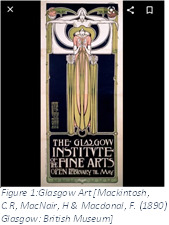
Cushion cover, Jessy Newbery, around 1900. The Scottish school was a gathering of craftsmen and planners who built up another and strikingly style in 1880s, they worked in Glasgow and Edinburgh making beautifying plans in which engineering, inside structure, furniture and fittings blended. They meant to deliver articles and situations that were fit to contemporary cosmopolitan life. The Scottish school style was in vogue from 1885 to 1915.
REFERRENCE: Walton, E.A. 1884. Tate; Glasgow School . Accessed on 31/08/19. URL: https://www.tate.org.uk/art/art-terms/g/glasgow-school
4. VIENNESE SECESSION
The Viennese Secession was a craftsmanship development shaped in 1897 by a gathering of Austrian craftsmen. This development incorporates painters, figures and planners.
Gustav klimt encircled his Nuda Veritas (1899). He made an intense image of the Vienna withdrawal and communicated its creative insubordination.
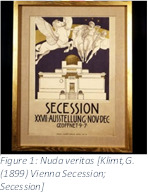
The most recent is craftsmanship by Beethoven Frieze (1902). It was painted on the inside dividers of the withdrawal building, it was protected however was not shown again until 1986 and it is presently for all time on view in the storm cellar. The image additionally propose their craving to orchestrate a contemporary craftsmanship from old and new, development and custom, which reacts to the expectations and wants of contemporary society.
REFERRENCE: Olbrich, J.M. 1897. The Art Story; Vienna secession. Accessed on 31/08/19. URL: https://www.theartstory.org/movement/vienna-secession/
5. FUTURISM
It was a creative and social development that began in Italy in the mid-20th century. Cubism added to the data of Italian futurism's creative style.
Craftsmanship by Gino Severini (1912). It underscores speed, innovation, youth, brutality and articles, for example, vehicle, the plane and the mechanical city.

Neo Futurism is a late twentieth to mid-21st century development in human expressions, plan and design. It could be viewed as take-off from the mentality of post-innovation and speaks to a hopeful faith in a superior future and a need to periodize the cutting edge affinity with the mechanical. Concentrating on advancement and innovation, the futurists looked to clear away customary creative ideas and supplant them with a fiery festival of the machine age.
REFERRENCE: Boccioni, U. 1910. The Art Story; Futurism. Accessed on 31/08/19. URL: https://www.theartstory.org/movement/futurism/
6. EXPRESSIONISM
It rose all the while in different urban communities crosswise over Germany as a reaction to a wide spread tension about mankind's inexorably dissonant association with the world and going with lost sentiments of genuineness and profoundly. Expressionism was propelled most vigorously by the symbolist flows in late 19th century craftsmanship.


Communicated in his composition is The Scream (1893), his accentuation upon exceptional inward experience set the way for expressionism, characterized by Ernst Kirchner as reflecting "the impressions of a man within recent memory."
Expressionism is an innovator development, at first in verse and painting, starting in Germany toward the start of the 20thy century. Its regular quality is to show the world exclusively from an abstract viewpoint, contorting it drastically for enthusiastic impact so as to summon mind-sets or thoughts.
This 1920 painting is the most recent called the "Mad woman", This canvas typifies the quintessence of expressionist style, Mad woman unmistakably vibrates, reshapes, moves, pushes and pulls, furnishing the watcher with Soutine's vision of the internal torment of his sitter.
REFERRENCE: Picabia, F. 1893. The Art Story; Expressionism. Accessed on 31/08/19. URL: https://www.theartstory.org/movement/Expressionism/
7. DADA
Dadaism was a craftsmanship development of the European cutting edge in the mid twentieth century.

Mona Lisa's artwork (1917) was changed by Duchamp. While it was at that point an outstanding gem, the attention from the robbery guaranteed that it wound up one of the most worshipped and popular centrepieces. On the postcard he drew a moustache and a goatee onto Mona Lisa's face.
The most recent is by beam 1922. His revelation of the rayography was its self-dependent on possibility, after he had neglected to uncover a picture and was holding on to show up in obscurity room, he set a few items on the photograph paper. After observing them, Tzara called them “pure dada creations” and they were a moment hit among the same disapproved of craftsmen. While man Beam did not imagine the photogram, his were the most celebrated.
REFERRENCE: Picabia, F. 1915. The Art Story; Dada. Accessed on 31/08/19. URL: https://www.theartstory.org/movement/dada/
8. SURREALISM
It is a social development that started in the mid-1920s and is best known for its visual works of art and compositions.
Inventive masterminds have consistently played with the real world, however in the mid twentieth century surrealism developed as a thoughtful and social development. Fuelled by the lessons of Freud and the defiant work of Dada craftsman and writers. Visual craftsman, artists, writers, arrangers and producers searched for approaches to free the mind and tap shrouded supplies of innovativeness.
Numerous craftsman on the planet are affected by surrealism styles, thought and systems. It's simple for a craftsman to
demonstrate their imagination through surrealism, on the grounds that the style gives them more opportunity to pass on their sentiments and contemplations through the canvas. Dreamlike craftsmanship can be marvellous or abrasive or it very well may be idealistic or discouraging.

REFERRENCE: Masson, A. 1976. Art Gallery; surrealism. Accessed on 31/08/19. URL: https://www.artsy.net/article/artsy-editorial-what-is-surrealism
0 notes
Text
Duinkerke en LAAC met de bus - een aanrader!
Veel mensen denken ten onrechte dat de enige manier om met het openbaar vervoer van Vlaanderen naar Frankrijk te gaan via Moeskroen - Lille Flandres is. Niets is minder waar. Bij het station van De Panne - Adinkerke is er een bushalte van DK’Bus, de busmaatschappij in Duinkerke en omstreken. Tot mijn verbazing zijn deze bussen volledig gratis! Elk uur rijden er twee van die bussen vanuit Adinkerke langs de Franse kustgemeentes Bray Dunes, Zuydcoote naar Leffrincoucke.
In Leffrincoucke kun je de overstap nemen met een bus die tot het station van Duinkerke rijdt. Ik had vandaag niets in het bijzonder te doen, dus besloot ik deze reis te ondernemen, met als bestemming het moderne kunstmuseum ‘Lieu d’Art et Action Contemporaine’ (LAAC). In totaal duurde de reis tussen mijn huis (in Torhout) en het LAAC in Duinkerke zo slechts twee uur. (Het is een afstand van 50 km). Onderweg kon ik mijn Frans wat oefenen in een kort gesprekje met een lokale buspassagier. Ook in het museum zelf hield ik even een praatje met een mevrouw drie daar werkte.
Hier volgt een korte beschrijving van het museum en de omstreken. Het museum heeft een beeldentuin.


Er zijn niet echt veel beelden te zien, maar ze zijn wel leuk, zoals deze gezellige kerel:
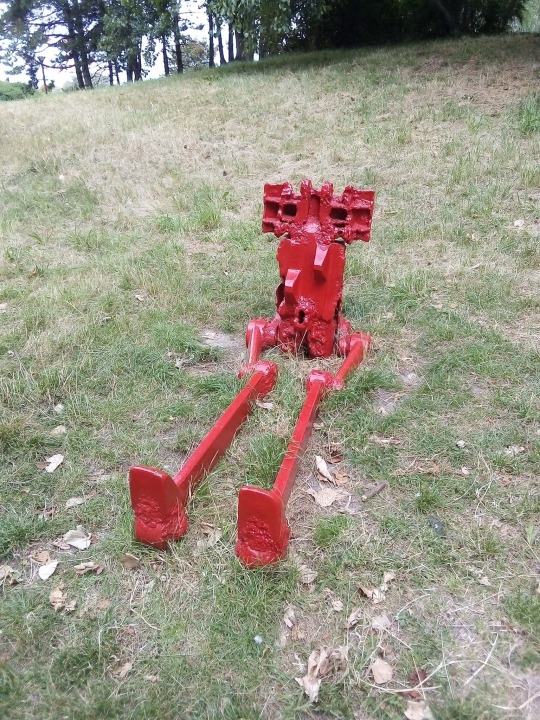
Of deze fantasierijke installatie die doet denken aan een veld vol gigantische klaprozen:
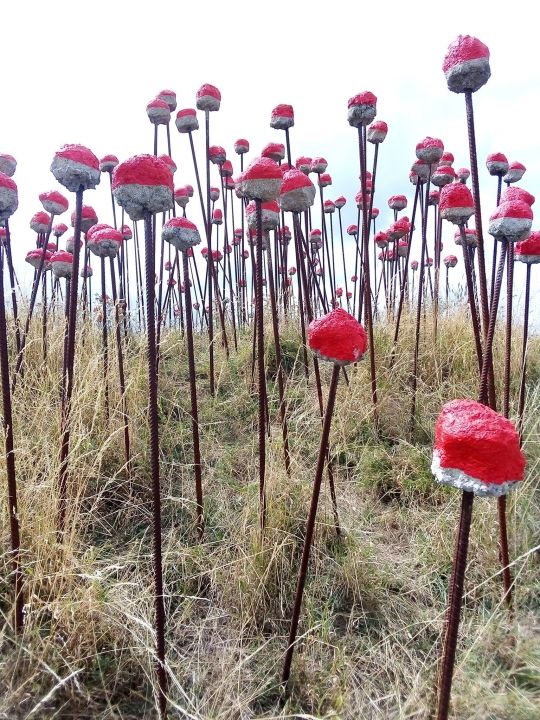
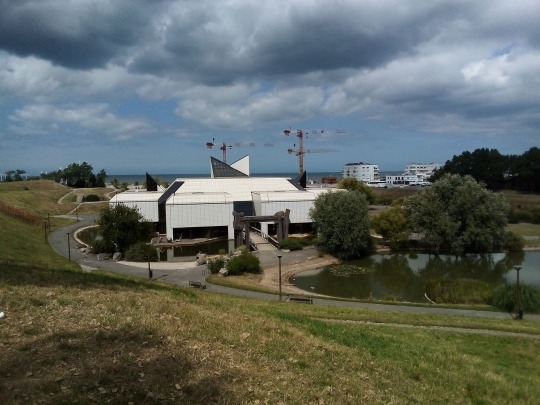
Dit is het LAAC zelf, gezien vanaf de beeldentuin. Ook de zee is al in zicht! Na vijf minuten stappen ben je er.
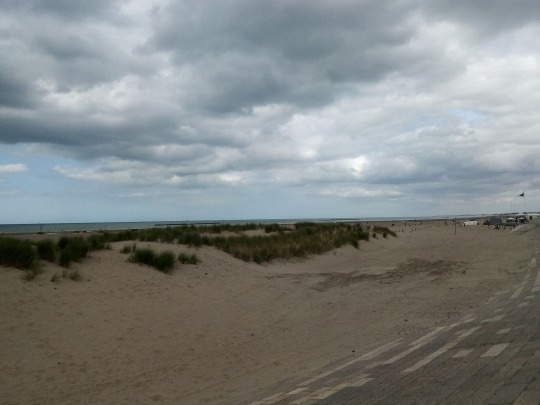
Het voelt net als een Belgisch strand aan, maar dan veel ruimer en breder. De zee en de wind en het zand zijn exact hetzelfde als elders, maar het is in Frankrijk!


Wegens een gebrek aan echte vrienden die vandaag meekonden heb ik voor een alternatief moeten zorgen. Nu, het LAAC is een klein museum, in een uur kun je het zeker volledig bezocht hebben. De twee hoogtepunten in de collectie waren volgens mij enerzijds de feestelijke installatie ‘Het Circus’ van Karel Appel:
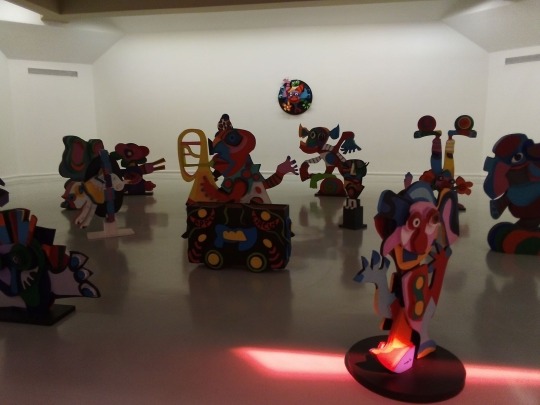

En anderzijds heeft het werk ‘le Musée de Ben’ door Ben (eigenlijk: Ben Vautier) iets van een postmodern meesterwerk. Net zoals traditionele kunstenaars met verf kunst maakten, schildert Ben zijn werk met woorden op alledaagse objecten. Ben gaat uit van het principe ‘Alles is kunst’ en voert dit door tot de meest extreme versie, met ironische en vaak komische resultaten. Zijn werk is vergelijkbaar met de vroegere dada uit de jaren ‘20 en wordt tot de ‘Fluxus’-beweging gerekend.

‘Le musée de Ben’ bestaat uit deze zwarte kast, gevuld met een aantal voorwerpen, waarbij soms poëtische, soms ironische, soms cynische teksten hangen.

Hier zien we naast een ‘namaak’ Yves Klein-werk, een ‘totale kunstluciferdoosje’, dat kan gebruikt worden om ‘alle kunst - musea - kunstgalerijen’ te ‘vernietigen’.

Of wat dacht je van deze ‘mysterieuze voeding’, die vooral mysterieus is omdat Ben ‘het etiket verwijderd heeft’. Vlak ernaast zien we een golfbal die blijkbaar God zou bevatten - ‘God is overal, inclusief in deze bal’.
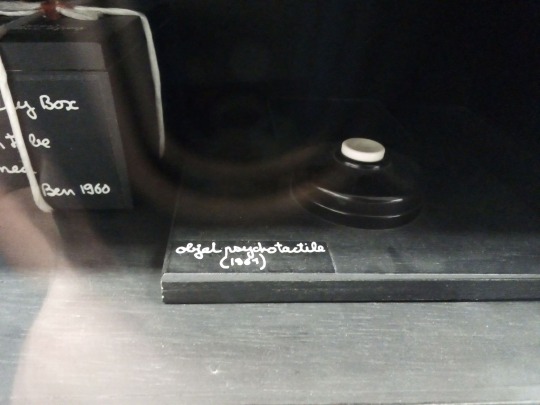
Is het een knop? Als het van Ben afhangt, is dit geen knop maar een ‘psychotactiel object’. Hoewel dit object van 1961 gedateerd is, kan je het zien als een soort ironische parodie op de toenemende invloed van het psychologisch en medisch taalgebruik op het taalgebruik in het dagelijkse leven. Maar Ben kan nog veel duidelijker provoceren dan dat:
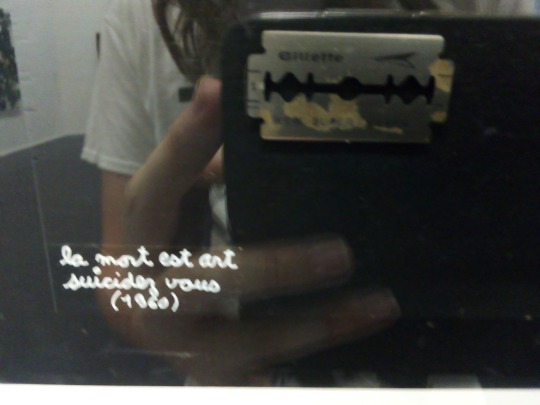
Hier zien we een scheermesje vergezeld van het opschrift: ‘de dood is kunst, pleeg zelfmoord’. Met dit stuk uit Bens ‘museum’ maakt hij terechte kanttekeningen bij de notie dat alles kunst is - want als alles kunst is, is de dood dan ook kunst (laat staan de zelfmoord)? Op frappante wijze tast Ben de grenzen af van deze overtuiging die tegenwoordig bon ton is in de hedendaagse kunstgalerijen.
Vooral de manier waarop Ben met taal speelt om het publiek te doen nadenken vind ik knap, zeker in een tijd waarin mensen vooral verward en eerder minder dan meer wijs uit het museum stappen. We mogen het woord niet verbannen uit de moderne kunst!
Na mijn museumbezoek geraakte ik weer met de DK’Bus vlot weer in België, en nam ik vervolgens de trein van De Panne naar Lichtervelde, en vervolgens de trein richting Brugge om in Torhout af te stappen. In Vlaanderen zou men soms durven vergeten dat de wereld niet stopt voorbij de Westhoek. Deze rit is zeker een aanrader, Duinkerke is een mooie en ondergewaardeerde stad!
En tant qu’exercice de français, et afin de maîtriser encore mieux la langue, j’ai rédigé une traduction française de cet article avec l’aide de Google Translate.
Il y a beaucoup de gens qui pensent à tort que la seule manière d'aller de Flandre en France par les transports en commun, c'est via Mouscron - Lille Flandres. Ce n'est absolumment pas le cas. Chez la gare de La Panne - Adinkerke, il y a un arrêt de bus de DK'Bus, la compagnie de bus de Dunkerque et ses environs. À ma grande surprise, ces bus sont complètement gratuits! Chaque heure, il y en a deux qui passent d'Adinkerke à Bray Dunes et Zuydcoote à Leffrincoucke.
À Leffrincoucke, c'est possible de descendre du bus et prendre un autre qui passe à la gare de Dunkerque. Aujourd'hui, je n'avais pas de grand chose à faire, donc j'ai décide de faire ce voyage, avec destination le musée des arts modernes ‘Lieu d’Art et Action Contemporaine’ (LAAC) Au total, le voyage entre ma maison (à Torhout) et le LAAC ne durait que deux heures. (C'est une distance de 50 km). Sur le chemin, je pourrais pratiquer mon Français en entretenant une courte conversation avec un passagère d'autobus locale. Aussi dans le musée, j'ai bavardé avec une dame qui y travaillait.
image
Voici une brève description du musée et de ses environs. Le musée possède un jardin des sculptures.
Il n y en a pas vraiment beaucoup à voir, mais elles sont en effet bonnes, comme ce mec particulier:
image
Ou cette installation imaginative qui rappelle un champ plein de coquelicots géants:
image
image
Voilà le LAAC, vu du jardin de sculpture. La mer est également visible! Après cinq minutes d'aller à pied, on y arrive.
image
On se croirait dans une plage belge, mais plus spacieux et plus large. La mer et le vent le sable sont exactement comme aillers, mais ici c'est en France!
À cause du manque de vrais amis qui pourraient m'accompagner aujourd'hui, j'ai dû proposer une alternative. Donc, le LAAC est un petit musée, on peut certainement l'avoir visité tout en une heure (mais moi j'ai pris deux heures). Les deux faits saillants de la collection étaient, selon moi, d'une part, l'installation festive 'Het Circus' (Le Cirque) de Karel Appel:
Et d'autre part, l'œuvre 'le Musée de Ben' de Ben (actuellement: Ben Vautier) quelque chose d'un chef-d'œuvre postmoderne. Comme les artistes traditionels font de l'art avec de la peinture, Ben peint ses œuvres en peignant avec des mots sur des objets du quotidien. Ben part du principe que 'Tout est art' et met en œuvre cela à la version la plus extrême, avec des résultats ironiques et souvent comiques. Son travail est comparable à celui de dada des années 1920 et il est considerée comme faisant partie du mouvement 'Fluxus'.
'Le Musée de Ben' consiste de cette armoire noire, rempli d'un certain nombre d'objets, chez lesquelles on voit des textes parfois poétiques, parfois ironiques, parfois cyniques.
À côté d'une œuvre 'faux Klein', on voit une 'boîte d'allummettes totale d'art', qui sert à 'détruire tout l'art - musées - galeries d'art'.
Ou que trouviez-vous de cet 'aliment mystérieux', qui est surtout mystérieux parcue Ben a 'enlevé l'étiquette'. Juste à côté, on voit une balle de golf, qui contiendrait Dieu car 'Dieu est partout, y compris dans cette balle'.
Ceci n'est pas un bouton. Si cela dépend de Ben, ceci n'est pas un bouton mais un 'object psychotactile'. Bien que ce object soit daté de 1961, on pourrait le voir comme une espèce de parodie ironique sur l'influence croissante du langage psychologique et médical sur notre langage familier. Mais Ben sait provoquer encore plus clairement que cela:
Voici une lame de rasoir accompagnée de l'inscription: 'la mort est art, suicidez-vous'. Avec cet œuvre du 'musée' de Ben, il critique à juste titre la notion que tout est art - parce que, si tout est art, est-ce que la mort est elle aussi art (encore moins le suicide)? Ben explore d'une manière frappante les limites de cette conviction aujourd'hui banale dans les galeries d'art contemporain.
J'aime particulièrement la façon dont Ben joue avec le langage pour faire réfléchir le public, certainement à une époque où les gens sont principalement confus et moins avisés en sortant le musée. Nous ne pouvons pas bannir le mot de l'art moderne!
Après ma visite au musée, je suis rapidement rentré en Belgique avec le DK'Bus, puis j'ai pris le train de La Panne à Lichtervelde, et alors le train à Bruges afin de descendre à Torhout (et y écrire cet article). En Flandres, on oublierait parfois que le monde ne s'arrête pas au-dèla la région Westhoek. Ce voyage est vraiment à recommander, Dunkerque est une belle ville sous-évalué!
0 notes
Text
Constantin Brâncuşi la Festivalul Dada de la Paris (26 mai 2020)
Constantin Brâncuşi la Festivalul Dada de la Paris (26 mai 2020)
Astăzi, 26 mai 2020 se împlinesc 100 de ani de când Constantin Brâncuşi a participat, la Paris, la Festivalul Dada de la Paris, alături de André Gide, Paul Valéry, Fernand Léger şi alţii, fiind unul dintre semnatarii manifestului intitulat Contre Cubisme, contre Dadaisme.
„În plin avânt al mișcărilor avangardiste, artistul român își arată o față pe care puțini o cunoscuseră și care a produs, în…
View On WordPress
#Adina Romanescu#Constantin Brâncuși#cultură#dada#Daniel Onaca#festival#Festivalul Dada 1920#ficţiune#Greta Knutson#istorie#literatură#muzică clasică#Paris#pictură#poezie#proză#revista trimestrială leviathan#societas#teatru#Tristan Tzara
0 notes
